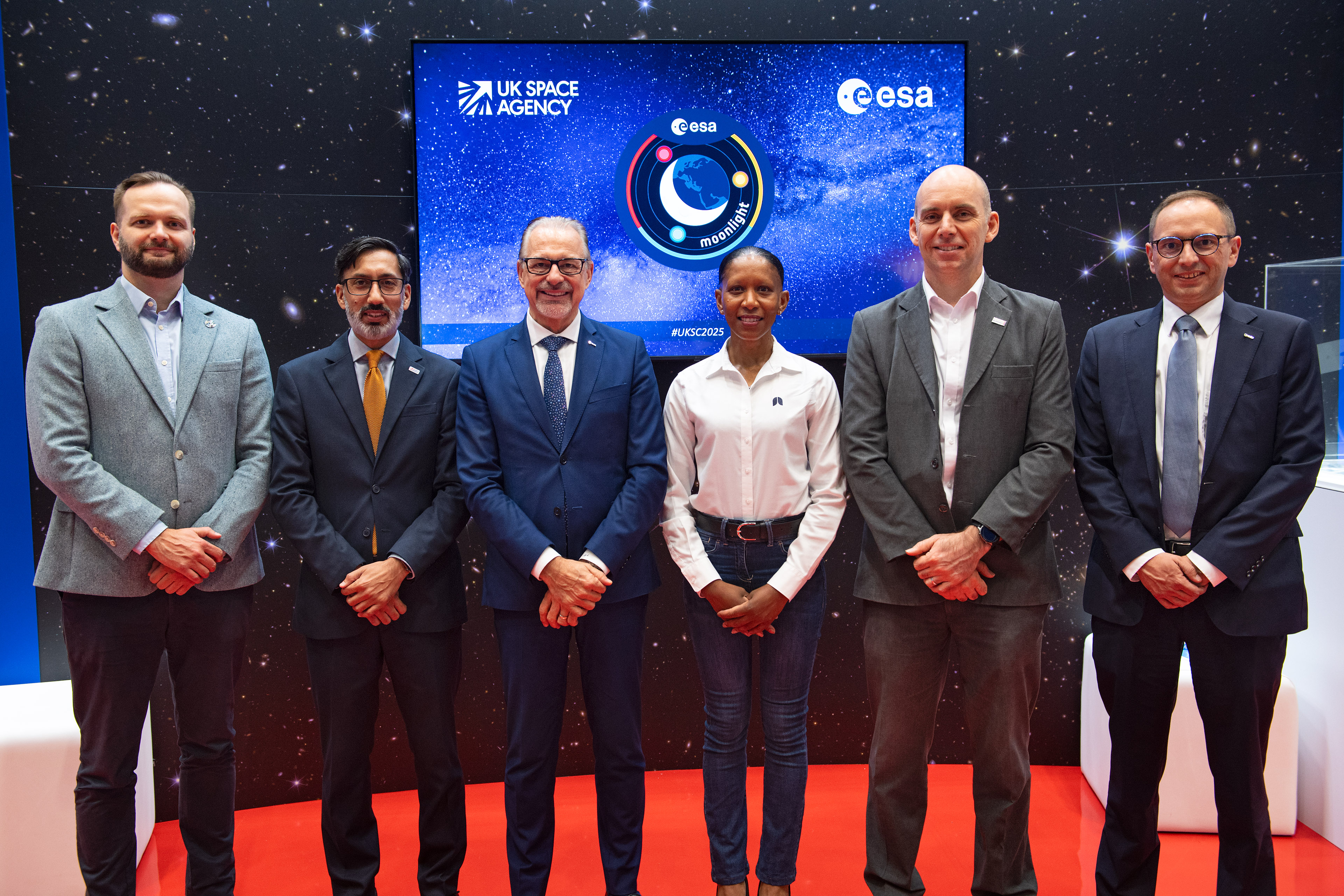Viasat begins work with MDA Space UK and SSTL on ESA's Moonlight programme

A new chapter began for the European Space Agency's (ESA) Moonlight this week as UK space industry companies, SSTL and MDA Space UK, joined the programme to bring on their extensive design and development expertise in lunar communications and space systems. Both companies will work with Viasat, who have the responsibility for the end-to-end Communications within the Moonlight Lunar Communication and Navigation Service (LCNS), led by Telespazio IT – a joint venture between Leonardo (67%) and Thales (33%).
The announcement took place during the UK Space Conference in Manchester, emphasising the UK Space Agency’s commitment to lunar exploration and development of deep space exploration technologies alongside ESA.
ESA’s Moonlight programme is a joint effort between the Agency's Directorate of Connectivity and Secure Communications, the Directorate of Navigation, and the Directorate of Human and Robotic Exploration. The programme’s purpose is to develop and provide commercial communications and navigation services on and around the Moon, enabling European autonomy in undertaking lunar exploration, while supporting the global sustainable return to the moon through the coordination of interoperability standards that will allow systems to work together to the benefit of users. The focus of the industry consortium under Moonlight's LCNS is the implementation of this infrastructure and the delivery of services.
Working with the UK Space Agency – a major Moonlight contributor – Viasat is also leading the UK space ecosystem to deliver the required lunar communications capabilities. MDA Space UK is a well-established space industry partner leveraging over 55 years of experience in satellite communications and space infrastructure with a wide array of expertise. SSTL on the other hand is already continuing its collaboration with ESA on Lunar activities, delivering the Lunar Pathfinder satellite – the first node for Moonlight is set to launch to lunar orbit in 2026.
The Moonlight programme is key to ensure sovereign European access to areas of scientific interest on and around the Moon as well as to provide infrastructure for research and exploration missions both for other ESA missions and commercial services for non-ESA affiliated missions. Without Moonlight, projects such as ESA’s Argonaut – Europe's lunar lander programme – would not be possible. It is one of the critical pillars of Lunar infrastructure needed for the future of manned exploration of our only natural satellite, but its utility spans far beyond upcoming robotics missions.
In the future, the Moon might become a home to data storage facilities, space weather monitoring outposts and deep space radio telescopes on the far side of the Moon, one of the most significantly radio quiet spaces in the solar system. Ultimately, Moonlight lowers the financial barrier for space exploration creating a highly interoperable service allowing even smaller missions to become more complex and access challenging areas of the Moon (the south pole, far side, craters in permanent shadow for example) by providing dedicated communications relay and navigation infrastructure for each mission. In the process, Moonlight taps into a forthcoming lunar economy predicted at €100 billion for industry to leverage.
Laurent Jaffart, Director of ESA's Connectivity and Secure Communications, said: “The welcome addition of SSTL and MDA Space brings our aim to establish communication and navigation on and around the Moon closer than ever, and I am particularly proud to see the UK space ecosystem playing a key role in helping us to get there. Moonlight is set to be a game changer for lunar exploration, making use of an interoperable infrastructure that will significantly enhance mission capabilities while reducing complexity and cost.”
Yasrine Ibnyahya, Vice President of Innovation, Viasat, said: “Moonlight is among the most exciting and ambitious projects being undertaken right now and will support future generations of space exploration. Our participation builds on our heritage of providing commercial satellite services and delivering highly innovative satellite programmes, but to get there we’ll need an ecosystem of experts all working together alongside the European and UK Space Agencies to make it happen. The UK, home to our International Business Headquarters, is an ideal place for us to lead the charge."
Andrew Cawthorne, Managing Director, Surrey Satellite Technology Ltd, said: “We’re proud to be part of the Viasat-led UK team that’s helping turn ESA’s Moonlight vision into reality. Building on our core role in Lunar Pathfinder and decades of experience in pioneering small satellite missions, SSTL is excited to contribute its expertise to delivering reliable, high-performance lunar communications services. Moonlight is a powerful example of the strength, ambition, and international relevance of the UK space sector.”
Mike Greenley, Chief Executive Officer of MDA Space, said: “MDA Space and our team in the UK are proud to be helping shape the future of lunar exploration through critical communications technologies that will enable the next wave of commercial and institutional missions. This milestone builds on our deep heritage in space infrastructure and reflects our growing capabilities in the UK. We look forward to continuing our collaboration with Viasat and SSTL as we define this vital system.”
Dr Craig Brown, Director of Investment at the UK Space Agency, said: “The UK has a proud legacy of innovation in satellite communications and enabling new commercial markets. The Moonlight programme offers a transformative opportunity for the UK to build a robust lunar communications infrastructure. Through collaboration between Viasat, SSTL and MDA Space, this initiative places the UK space sector at the forefront of the emerging lunar economy - expected to generate tens of billions in global revenue—while creating high-skilled jobs and showcasing the depth of British industry. By supporting this initiative, we’re making the lunar surface more accessible for scientific and commercial activities.”


